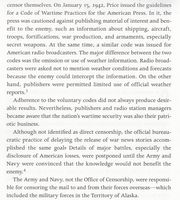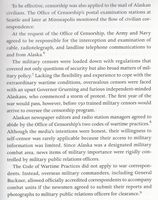
Alaska's Hidden Wars: Secret Campaigns on The North Pacific Rim
 |
cover.jpg
2004
This is a book that examines one of the most ignored areas of WWII, and that is the struggle against the Japanese in Alaska and the Aleutian Islands. It discusses the Japanese holding of some of the American islands, the North Pacific weather, information found on captured Japanese prisoners, the use of Nisei interpreters, the influence of the Soviets in the area, and various other topics.
 |
This relates to the establishment of an Office of Censorship.
 |
The regular media was not officially censored, but steps were taken that amounted to pretty much the same thing.
 |
Alaska became a military combat zone.
 |
Censorship in Alaska, and who was doing what.
There apparently weren't many Japanese in Alaska. The author says some 263 were relocated out of Alaska, of which 88 were Issei. That means about two-thirds of those relocated were actually American citizens, Nisei.
The Japanese did attack along the Aleutians, centering on Dutch Harbor, for example, where three Americans ended up becoming the first three American prisoners-of-war. On the island of Kiska there was a very small group of weathermen, and the Japanese landed and eventually took all of them prisoner, also.
The Japanese also invaded Attu, and the U.S. government evacuated a number of Aleuts from various areas, shipping them to southeastern Alaska.
ATC was the Alaska Travel Control which was a military group set up to control civilian access to Alaska.
 |
The military control and censorship of information was kept very strictly, even though the threat of an actual attack on Alaska had pretty much gone away.
Nisei were used as translators, even though their own families were often ones still in the internment camps. The Japanese, the author notes, had not figured on the U.S. having or using the Nisei as translators, and that was a mistake on their part. The Japanese also were unable to stop their troops from keeping diaries, and, from time to time, these were found, usually on the bodies of dead Japanese soldiers, and some proved useful to the U.S. military.
There's a humorous note where the author writes about some of the Nisei making fake Japanese battle flags, and then selling or trading these “captured flags.”
The battle for Attu featured another useless banzai charge, where the commander and about a thousand men attack the American lines. They had some success but as in every banzai charge that I have read about, the ultimate result was annihilation for the attacking Japanese forces. A very small number of prisoners were taken, but many of the Japanese preferred to blow themselves up with their own grenades rather than be captured.
The author goes on to talk about how the Japanese media portrayed the “brave defenders” of Attu, and how Japan might be invaded by the U.S. launching forces from the Aleutian Islands. Such a thing was almost, although not totally, impossible due to the weather conditions in the area which would have made a major invasion, by either side, an incredibly difficult, nearly impossible thing to carry out successfully.
The worry kept about 100,000 Japanese troops in the area for a good while, which, of course, met that many fewer troops involved where the action really was going on. Eventually the troop strength was reduced to around 25.000.
Starting in 1944, the author says, some of the evicted Japanese-Americans were allowed to return to Alaska, and later others were able to return. There were some Aleuts that had been taken by the Japanese and placed into internment camps, and, of those, about 40% died.
This is a fairly decent book, although I have better and more complete ones.
Main Index
Japan main page
Japanese-American Internment Camps index page
Japan and World War II index page
|
|